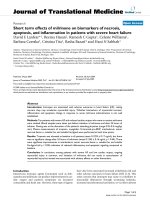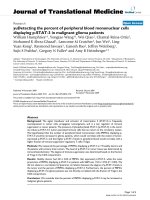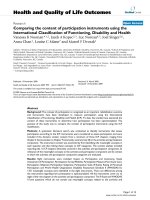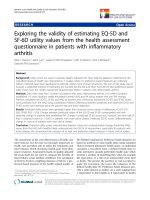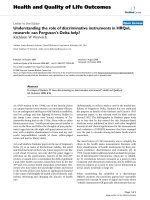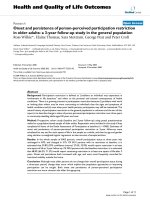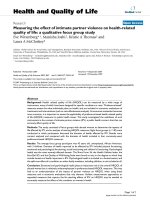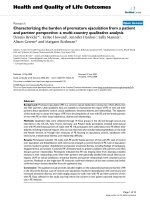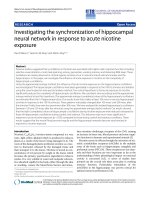Báo cáo hóa học: " Modeling the effects of drug resistant influenza virus in a pandemic" doc
Bạn đang xem bản rút gọn của tài liệu. Xem và tải ngay bản đầy đủ của tài liệu tại đây (264.06 KB, 6 trang )
BioMed Central
Page 1 of 6
(page number not for citation purposes)
Virology Journal
Open Access
Short report
Modeling the effects of drug resistant influenza virus in a pandemic
Stefan O Brockmann
1
, Markus Schwehm
2
, Hans-Peter Duerr
2
, Mark Witschi
3
,
Daniel Koch
3
, Beatriz Vidondo
3
and Martin Eichner*
2
Address:
1
Department of Epidemiology and Health Reporting, Baden-Württemberg State Health Office, District Government Stuttgart, Germany,
2
Department of Medical Biometry, University of Tübingen, Germany and
3
Swiss Federal Office for Public Health, Bern, Switzerland
Email: Stefan O Brockmann - ; Markus Schwehm - ; Hans-Peter Duerr - hans-
; Mark Witschi - ; Daniel Koch - ;
Beatriz Vidondo - ; Martin Eichner* -
* Corresponding author
Abstract
Neuraminidase inhibitors (NI) play a major role in plans to mitigate future influenza pandemics.
Modeling studies suggested that a pandemic may be contained at the source by early treatment and
prophylaxis with antiviral drugs. Here, we examine the influence of NI resistant influenza strains on
an influenza pandemic. We extend the freely available deterministic simulation program InfluSim to
incorporate importations of resistant infections and the emergence of de novo resistance. The
epidemic with the fully drug sensitive strain leads to a cumulative number of 19,500 outpatients and
258 hospitalizations, respectively, per 100,000 inhabitants. Development of de novo resistance alone
increases the total number of outpatients by about 6% and hospitalizations by about 21%. If a
resistant infection is introduced into the population after three weeks, the outcome dramatically
deteriorates. Wide-spread use of NI treatment makes it highly likely that the resistant strain will
spread if its fitness is high. This situation is further aggravated if a resistant virus is imported into a
country in the early phase of an outbreak. As NI-resistant influenza infections with high fitness and
pathogenicity have just been observed, the emergence of drug resistance in treated populations and
the transmission of drug resistant strains is an important public health concern for seasonal and
pandemic influenza.
Findings
Neuraminidase inhibitors (NI) play an important role in
plans to mitigate future influenza pandemics [1]. Mode-
ling studies suggested that a pandemic may be contained
at the source, if treatment and prophylaxis are applied in
an early phase of the epidemic. Large amounts of NI
(mainly oseltamivir) have been stockpiled in many coun-
tries to prepare for pandemic influenza, and many
national preparedness plans rely on this. However,
recently doubts have been raised whether this strategy is
realistic. Timeliness of the intervention due to difficulties
in early recognition and logistic challenges are some of the
points considered. The development of NI resistance is of
further concern.
Influenza viruses undergo continuous genetic changes by
means of mutation and recombination, promoting the
emergence of drug resistant strains. Viral resistance may
develop by modifications in the amino acid composition
of the neuraminidase or in the affinity of haemagglutinin
to the receptors of the cell surface [reviewed in [2]]. Prior
to the 2007/8 influenza season, NI resistant strains were
Published: 30 October 2008
Virology Journal 2008, 5:133 doi:10.1186/1743-422X-5-133
Received: 5 August 2008
Accepted: 30 October 2008
This article is available from: />© 2008 Brockmann et al; licensee BioMed Central Ltd.
This is an Open Access article distributed under the terms of the Creative Commons Attribution License ( />),
which permits unrestricted use, distribution, and reproduction in any medium, provided the original work is properly cited.
Virology Journal 2008, 5:133 />Page 2 of 6
(page number not for citation purposes)
found in patients after treatment with oseltamivir and in
patients not exposed to oseltamivir. Resistance to NI
occurred at a low level: less then 1% of immuno-compe-
tent patients were found to be infected with resistant virus
[3]. The emergence of a resistant strain may not necessar-
ily be dangerous, as the "fitness" of the resistant strain
determines its transmissibility [4,5]. Most resistant strains
lacked "fitness" and were unlikely to spread, but early sur-
veillance data from the 2007/8 influenza season on the
northern hemisphere suggest that an oseltamivir resistant
influenza virus type A(H1N1) circulates in several Euro-
pean countries and in the US [6,7]. The proportion of
resistant infections ranges between 4% and 67% (mean
20%, approximately 1.700 tested isolates) and have been
reported from 15 of 25 European countries under surveil-
lance [8].
To obtain a better understanding of the consequences
associated with the widespread use of NI as first-line
option against a novel pandemic influenza strain, we
extend the freely available simulation program InfluSim
to simulate the emergence and spread of NI resistant
strains [9,10]. We examine how the numbers of outpa-
tients and hospitalizations change if resistance emerges de
novo and is imported into a population in the early phase
of an outbreak. We compare scenarios with and without
the presence of drug resistance, using a basic reproduction
number R
0
of 2.5 [11]. R
0
is the expected number of sec-
ondary infections per case in a completely susceptible
population without interventions (it is calculated as the
maximum eigenvalue of the next generation matrix)
[12,13]. The fitness of the resistant infection, i.e. its capa-
bility to spread from person to person, is assumed to be
the same as that of the drug sensitive one. Concordant to
historical data and most pandemic plans [see [13,14]], we
assume that one third of all infected individuals remain
asymptomatic, one third becomes moderately sick and
one third becomes severely sick and seeks medical help.
All cases who seek medical help ('outpatients') are offered
antiviral treatment, and we assume that the NI stockpile is
sufficiently large. General (unspecified) social distancing
measures [15,16] are simulated by reducing the number
of contacts within the population by 10%. Isolation addi-
tionally reduces the number of contacts of moderately
sick cases by 10%, of severe cases who stay at home by
20%, and of hospitalized cases by 30%. On day zero, a
single infection (which is either drug sensitive or drug
resistant) is introduced into a fully susceptible popula-
tion. On day 21, a second introduction follows (again
drug sensitive or resistant). Drug resistance is assumed to
develop additionally de novo during the course of the pan-
demic wave (we assume that 4.1% of children and teenag-
ers and 0.32% of adults [cf. [17-19]] infected with the
drug sensitive virus develop a resistant infection when tak-
ing antiviral drugs. Cases infected with the resistant virus
do no longer respond to antiviral treatment. We report the
incidence and total number of outpatients and hospitali-
zations during the course of the pandemic wave in a Swiss
population of 100,000 inhabitants. The emergence and
the initial spread of drug resistance are highly stochastic.
Deterministic simulations as those presented here give
average or mean courses of the resulting dynamics, but do
not show the full stochastic range of results.
Without drug resistance, the simulated influenza epi-
demic causes 19,500 outpatients and 258 hospitalizations
per 100,000 inhabitants. If only drug sensitive infections
are imported, and drug resistance develops only de novo,
the number of outpatients increases to 20,700 (106%)
and the number of hospitalizations increases to 312
(121%; Table 1). If resistant infections do not only
develop de novo, but are imported into the population 21
days after onset of the epidemic, the numbers rise to
22,700 (116%) outpatients and to 420 (163%) hospitali-
zations. If the resistant strain is imported before the drug
sensitive one, numbers even rise to 25,100 (129%) outpa-
tients and 601 (233%) hospitalizations, (Table 1). The
latter values do not change if the resistant strain is
imported a second time on day 21.
If a resistant strain emerges only de novo, its prevalence
may remain low, implying little epidemiological conse-
quences (Figure 1a). Importation of resistance, however,
increasingly replaces the drug sensitive strain because the
latter is continuously eliminated by treatment. The domi-
nance of the resistant strain depends on when its impor-
tation starts. E. g. if a drug resistant strain is imported 21
days after seeding the epidemic (with a sensitive strain),
the prevalence curve for the resistant strain mimics in a
delayed shape the prevalence of the sensitive strain (Fig-
Table 1: Expected number of outpatients and hospitalizations in various scenarios with drug resistant infections
1
st
infection imported on day 0 2
nd
infection imported on day 21 Total number of outpatients Total number of hospitalizations
sensitive strain sensitive strain 20,700 313
sensitive strain resistant strain 22,700 420
resistant strain sensitive strain 25,100 601
resistant strain resistant strain 25,100 601
All patients who seek medical help ('outpatients') are offered antiviral treatment. The scenario without drug resistant infection leads to 19,500
outpatients and 258 hospitalizations, respectively. Population size 100,000; parameter values see Figure 1 and text.
Virology Journal 2008, 5:133 />Page 3 of 6
(page number not for citation purposes)
Figure 1 (see legend on next page)
Infections
0
5000
10000
15000
20000
25000
30000
0 20 40 60 80 100 120
Day
0
20
40
60
80
100
Prop. of infections caused
by resistent strain (%)
Infections
0
5000
10000
15000
20000
25000
30000
0
20
40
60
80
100
Prop. of infections caused
by resistent strain (%)
Infections
0
5000
10000
15000
20000
25000
30000
Prop. of infections caused
by resistent strain (%)
0
20
40
60
80
100
a
b
c
Virology Journal 2008, 5:133 />Page 4 of 6
(page number not for citation purposes)
ure 1b). If the time point for the importation of the resist-
ant strain is shifted towards the initial phase of the
epidemic, the resistant strain increasingly replaces the sen-
sitive strain (Figure 1c). Early importation of resistant
infection increases the number of treatment failures and
thus, increases the overall number of infections emerging
from the epidemic (Figure 1a–c). A sensitivity analysis
which addresses the influence of the non-pharmaceutical
interventions on these results is presented as an additional
file (Additional file 1). Figure 2 illustrates the total num-
bers of (a) outpatients, (b) hospitalizations, and (c)
deaths in dependence of a given time delay between the
importation of the drug sensitive and the drug resistant
infection (0–30 days).
Current mathematical models focus more on de novo drug
resistance than on imported and spreading resistant infec-
tions [5,20,21]. Although de novo development of NI
resistance may occur so late within a treated patient that
the patient is unlikely to pass on the infection, wide-
spread use of treatment makes it highly likely that resist-
ant virus will circulate in the population if its relative fit-
ness is high. We show in our simulations, that the
development of de novo resistance on a low level and the
subsequent spread of resistant virus results in a substan-
tially increased number of hospitalizations, and subse-
quently in more ICU patients and deaths. Especially the
shortcoming in the availability of intensive care beds has
to be considered [22,23]. This situation is aggravated if an
already resistant virus is imported into a population in the
early phase of an epidemic. Up to now, only little atten-
tion has been paid to such scenarios. Observations in the
early phase of the 2007/8 influenza season showed a
marked increase of oseltamivir resistant influenza A virus
(H1N1) in various European countries. The current osel-
tamivir resistant virus does not pose any risk to cause a
pandemic as the H1N1 strain has been circulating in the
population for many years without pandemic potential
and leaving the population at least partially immune. The
implications for avian influenza H5N1 remain uncertain.
Oseltamivir resistance due to the same mutation has been
reported in three patients with H5N1 infection who were
treated with oseltamivir. As H5N1 viruses have not yet
shown the ability to spread efficiently from person to per-
son there seems currently no potential for a similar
increase. However, the appearance of a spreading NI-
resistant seasonal influenza strain is unexpected and of
great concern. It highlights that even in the absence of
widespread NI use for treatment or prophylaxis, oseltami-
vir resistant strains can emerge and spread in the popula-
tion [6]. It also highlights the importance of our
simulations for the elaboration of appropriate control
and prevention strategies. We point out that the early
introduction of a resistant influenza virus with pandemic
potential may easily become an overwhelming public
health problem. An increase of infections of 30% and a
more than doubled total number of hospitalizations dem-
onstrate this challenge. Non-pharmaceutical interven-
tions considered by health decision makers and
occupational medicine specialists in their pandemic pre-
paredness plans may play a crucial role.
List of abbreviations
NI: Neuraminidase inhibitors; R
0
: basic reproduction
number.
Competing interests
The authors declare that they have no competing interests.
Authors' contributions
SOB and ME conceived the research question of the study,
analyzed the simulation results and drafted the manu-
script. ME and MS formulated and programmed the
model in Java and delivered the simulation results. HPD
participated in the design of the study, performed the sta-
tistical analysis, produced the figure and helped to draft
the manuscript. DK, MW and BV participated in its design
and coordination and helped to draft the manuscript. All
authors read and approved the final manuscript.
Prevalence of infection with the drug sensitive virus (solid lines in black), the drug resistant one (dashed lines) and the sum of both (dotted lines)Figure 1 (see previous page)
Prevalence of infection with the drug sensitive virus (solid lines in black), the drug resistant one (dashed lines)
and the sum of both (dotted lines). All cases who seek medical help ('outpatients') receive antiviral treatment. The grey
curves indicate the fractions of resistant infections among all infections. In all 3 graphs, resistance develops de novo in 4.1% of
children and 0.32% of adults who receive treatment. (a) Drug-sensitive infections are imported on day 0 and 21; (b) Drug sen-
sitive infection is imported on day 0, followed by a drug-resistant one on day 21; (c) Drug resistant infection is imported on day
0, followed by a drug-sensitive one on day 21. Further assumptions: (1) Swiss population of 100,000 individuals. (2) R
0
= 2.5 for
the drug sensitive and the drug resistant virus. Both strains are assumed to have the same transmissibility. (3) One third of all
infected individuals become severely sick and seek medical help. Antiviral treatment reduces their contagiousness by 80% and
their duration of sickness by 25% if they are infected with the drug sensitive virus. (4) General social distancing reduces the
number of contacts by 10% for all individuals; isolation additionally prevents 10%, 20% and 30% of contacts of moderately sick
cases, severely sick cases at home, and hospitalized cases, respectively. For references about assumptions and parameter values
see text.
Virology Journal 2008, 5:133 />Page 5 of 6
(page number not for citation purposes)
The solid curves show the expected total numbers of (a) outpatients, (b) hospitalizations, and (c) deaths, respectively, during a pandemic wave in a population of 100,000 inhabitants where on day 0 a drug-sensitive infection is imported, followed by a drug-resistant one after the time delay given on the horizontal axisFigure 2
The solid curves show the expected total numbers of (a) outpatients, (b) hospitalizations, and (c) deaths,
respectively, during a pandemic wave in a population of 100,000 inhabitants where on day 0 a drug-sensitive
infection is imported, followed by a drug-resistant one after the time delay given on the horizontal axis. With-
out introduction of a resistant infection, 20,700 outpatients, 314 hospitalizations and 82 deaths are expected (dashed reference
lines). If resistant infection is neither introduced de novo nor imported, 19,500 outpatients, 258 hospitalizations and 66 deaths
are expected (dotted reference lines). Parameter values see Figure 1 and text.
Days between first and second introduction
Outpatients
0
5000
10000
15000
20000
25000
Hospitalisations
0
100
200
300
400
500
600
Deaths
0
20
40
60
80
100
120
140
160
0 5 10 15 20 25 30
a
b
c
Publish with BioMed Central and every
scientist can read your work free of charge
"BioMed Central will be the most significant development for
disseminating the results of biomedical research in our lifetime."
Sir Paul Nurse, Cancer Research UK
Your research papers will be:
available free of charge to the entire biomedical community
peer reviewed and published immediately upon acceptance
cited in PubMed and archived on PubMed Central
yours — you keep the copyright
Submit your manuscript here:
/>BioMedcentral
Virology Journal 2008, 5:133 />Page 6 of 6
(page number not for citation purposes)
Additional material
Acknowledgements
This work has been partly supported by a project of the SFOPH (contract
no. 06.001333/304.0001-108), the EU projects SARScontrol (FP6 STREP;
contract no. 003824) (HPD) and INFTRANS (FP6 STREP; contract no.
513715) (MS). We thank M. Mäusezahl and HC Matter for their support
and for reviewing a previous version of the manuscript.
References
1. Strengthening pandemic-influenza preparedness and
response, including application of the International Health
Regulations (2005). Fifty-ninth World Health Assembly.
WHO document A59/4 [ />WHA59/A59_4-en.pdf]
2. Updated review of influenza antiviral medicinal products for
potential use during pandemic by the Committee for Medic-
inal Products for Human Use (CHMP) of the European Med-
icines Agency (EMEA) [ />human/pandemicinfluenza/antivirals.htm]
3. Monto AS, McKimm-Breschkin JL, Macken C, Hampson AW, Hay A,
Klimov A, Tashiro M, Webster RG, Aymard M, Hayden FG, Zambon
M: Detection of influenza viruses resistant to neuraminidase
inhibitors in global surveillance during the first 3 years of
their use. Antimicrob Agents Chemother 2006, 50:2395-2402.
4. Herlocher ML, Truscon R, Elias S, Yen HL, Roberts NA, Ohmit SE,
Monto AS: Influenza viruses resistant to the antiviral drug
oseltamivir: transmission studies in ferrets. J Infect Dis 2004,
190:1627-1630.
5. Stilianakis NI, Perelson AS, Hayden FG: Emergence of drug resist-
ance during an influenza epidemic: insights from a mathe-
matical model. J Infect Dis 1998, 177:863-873.
6. Interim ECDC Risk Assessment – Emergence of seasonal
influenza viruses type A/H1N1 with oseltamivir resistance in
some European Countries at the start of the 2007–8 influ-
enza season [ />]
7. Lackenby A, Hungnes O, Dudman SG, Meijer A, Paget WJ, Hay AJ,
Zambon MC: Emergence of resistance to oseltamivir among
influenza A(H1N1) viruses in Europe. Euro Surveill 2008, 13(5):.
8. Update A(H1N1) viruses resistant to oseltamivir [http://
www.eiss.org/html/lb_h1n1_resistance_oseltamivir.html]
9. Ward P, Small I, Smith J, Suter P, Dutkowski R: Oseltamivir (Tami-
flu) and its potential for use in the event of an influenza pan-
demic. J Antimicrob Chemother 2005, 55(Suppl 1):i5-i21.
10. Whitley RJ, Hayden FG, Reisinger KS, Young N, Dutkowski R, Ipe D,
Mills RG, Ward P: Oral oseltamivir treatment of influenza in
children. Pediatr Infect Dis J 2001, 20:127-133.
11. Aoki FY, Boivin G, Roberts N: Influenza virus susceptibility and
resistance to oseltamivir. Antivir Ther 2007, 12:603-616.
12. Dietz K: The estimation of the basic reproduction number for
infectious diseases. Stat Methods Med Res 1993, 2:23-41.
13. Eichner M, Schwehm M, Duerr HP, Brockmann SO: The influenza
pandemic preparedness planning tool InfluSim. BMC Infect Dis
2007, 7:17.
14. Duerr HP, Brockmann SO, Piechotowski I, Schwehm M, Eichner M:
Influenza pandemic intervention planning using InfluSim:
pharmaceutical and non-pharmaceutical interventions. BMC
Infect Dis 2007, 7:76.
15. Jefferson T, Foxlee R, Del Mar C, Dooley L, Ferroni E, Hewak B, Pra-
bhala A, Nair S, Rivetti A: Interventions for the interruption or
reduction of the spread of respiratory viruses. Cochrane Data-
base Syst Rev 2007:CD006207.
16. Sande M van der, Teunis P, Sabel R: Professional and home-made
face masks reduce exposure to respiratory infections among
the general population. PLoS ONE 2008, 3:e2618.
17. Chowell G, Nishiura H, Bettencourt LM: Comparative estimation
of the reproduction number for pandemic influenza from
daily case notification data. J R Soc Interface 2007, 4:155-166.
18. Ferguson NM, Cummings DA, Cauchemez S, Fraser C, Riley S, Meeyai
A, Iamsirithaworn S, Burke DS: Strategies for containing an
emerging influenza pandemic in Southeast Asia. Nature 2005,
437:209-214.
19. Longini IM Jr, Halloran ME, Nizam A, Yang Y: Containing pandemic
influenza with antiviral agents. Am J Epidemiol
2004,
159:623-633.
20. Ferguson NM, Mallett S, Jackson H, Roberts N, Ward P: A popula-
tion-dynamic model for evaluating the potential spread of
drug-resistant influenza virus infections during community-
based use of antivirals. J Antimicrob Chemother 2003, 51:977-990.
21. Regoes RR, Bonhoeffer S: Emergence of drug-resistant influ-
enza virus: population dynamical considerations. Science
2006, 312:389-391.
22. Menon DK, Taylor BL, Ridley SA: Modelling the impact of an
influenza pandemic on critical care services in England.
Anaesthesia 2005, 60:952-954.
23. van Genugten ML, Heijnen ML: The expected number of hospi-
talisations and beds needed due to pandemic influenza on a
regional level in the Netherlands. Virus Res 2004, 103:17-23.
Additional File 1
Sensitivity analysis on the influence of social distancing measures in
the comparison of reintroduction of drug sensitive and drug resistant
infection. The data provided represent the sensitivity analysis on the influ-
ence of social distancing measures on the number of outpatients and hos-
pitalizations.
Click here for file
[ />422X-5-133-S1.doc]
